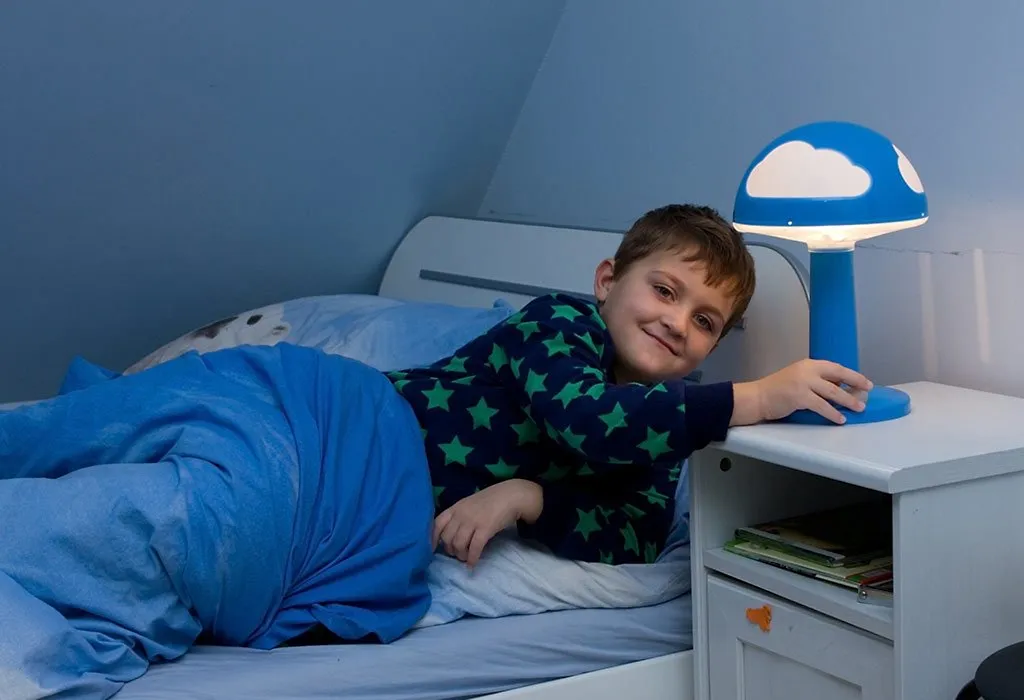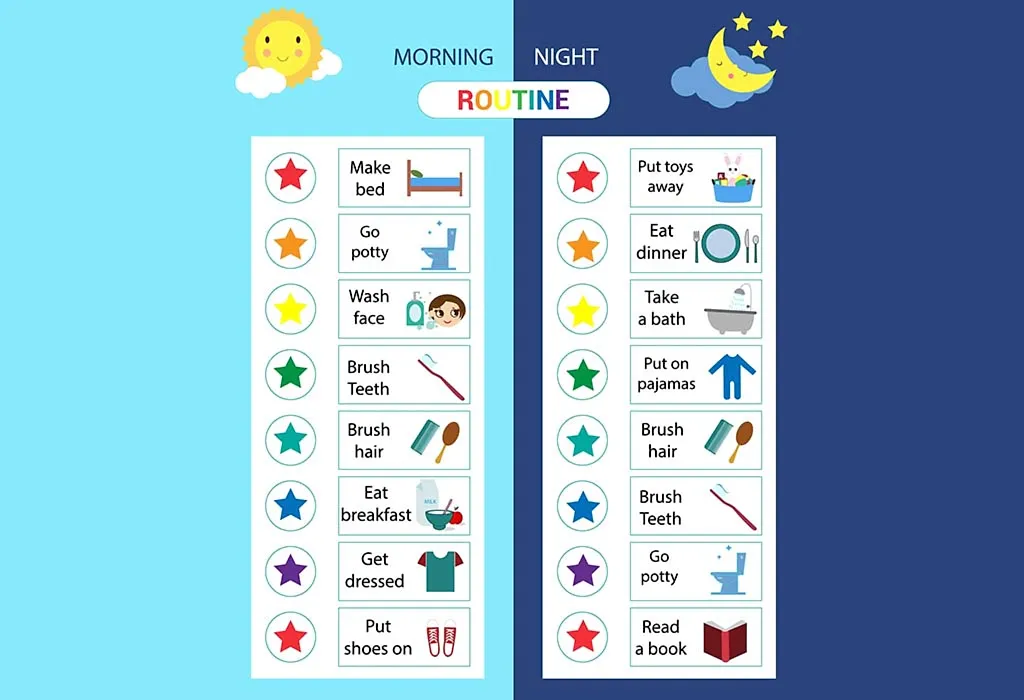Daily Routine for Kids: Importance, Sample Charts & Tips
- Importance of Establishing a Daily Routine for Children
- Things to Keep in Mind While Setting a Daily Routine for Kids
- Sample Daily Routine Chart for Children
- How to Encourage Your Kids to Follow a Daily Routine
- What Happens When a Child Has No Routine
- FAQs
A big challenge that parents today face is the lack of routine in the lives of their kids. It is very important to cultivate a habit of following a routine to help kids cope with changes in their lives. A routine instils a basic level of discipline in their lives and keeps them both mentally and physically engaged. It also challenges them to complete tasks within a stipulated time frame, so they know the importance of time management.
Children who follow a predictable routine are well equipped to deal with changes and rise up to the occasion, as the edifice of their existence is well-structured (1). It is, however, important to balance strictness and rigidity in following a routine.
Importance of Establishing a Daily Routine for Children
A child’s brain needs constant engagement, stimulation and challenge to be groomed into a well-rounded personality. Establishing a routine should be restricted to performing the daily chores of one’s life and leave some time of the day as unstructured to help kids gain insight into their strengths and weaknesses. Structure and routine should be enforced to help kids take control of themselves, adopt constructive habits to be able to adapt to different situations in life. Here are other benefits of a daily routine (2).
1. Eliminates Power Struggles at Home
Routine works well in eliminating power issues at home as you don’t need to constantly monitor your child’s activities. (brushing, napping, turning off the TV, meal times). You can avoid constant nagging, which helps to not portray you as the bad one.
2. Increases Cooperation from Kids
A routine encourages kids to cooperate and reduces stress and anxiety in the house. Everyone is aware of the flow with each activity completed without any chaos
3. Helps Kids Become Responsible
When kids learn to brush their teeth, pack their bags, do their homework and eat their meals without constant reminders, it inculcates a sense of responsibility in them. They eventually like the fact that they are in charge of themselves. They become competent and don’t rebel.

4. The Concept of “Looking Forward” to Exciting Activities
Kids learn that they will get to enjoy certain activities like going to the park or for a playdate only if they finish their routine chores on time. They manage their time to win some extra time for fun activities.
5. Establishing a Schedule
A regular routine establishes a schedule which works in clockwise precision and helps children fall asleep sooner.
6. Increases Bonding
Incorporating some moments of love and affection with your child will motivate them to do complete their tasks. Snuggle up to them before going to bed, or even a tight, good morning hug helps you connect at an intuitive level, building security and cooperation in your relationship.
7. Helps Parents Find Consistency in Daily Life
Parents who skip routines or trade them off for settling a dispute often find themselves burdened. But when everything is fixed, healthy expectations are floated around, and eventually, the household runs smoothly.
8. Manage Discipline Issues, Stress and Anxiety
Working parents are often faced with stressful situations, with their kids displaying a lack of discipline and disregard for rules. But with a routine established, things could work predictably, adding a bit of calm to the stressful times (3).
9. Kids Know What a Day Looks Like
A fixed routine helps kids to know what a typical weekday or weekend would look like. So they are not thrown off guard, which induces a sense of security and reduces stress.
10. Reduces Arguments and Discussions
A routine saves you from having lengthy arguments, discussions and justifications for the completion of tasks. Your kids will focus 100% on brushing their teeth before breakfast as that is what is expected.
Things to Keep in Mind While Setting a Daily Routine for Kids
A structured family life is definitely very reassuring, and research has proved that a scheduled lifestyle leads to a healthy life. But there are certain things that we need to keep in mind while setting a routine for kids. We need to work around the following:
1. Build a Routine that Suits Your Child
A routine should be built around the times kids wake up, eat and sleep, so that it comes naturally to them to follow it.
2. Keep Your Expectations Real
Realistic timelines should be set with enough “waste time” for children to adapt to the pattern.
3. Incorporate Everything
Don’t forget to add extras to the routine that your family has, like chore time, personal conversations with each child in case of more than one kid, school clubs and classes.
4. Night-time Routine Should Help Prepare for the Next Day
Ensure night time routine includes preparation for the next day- packing bags, sorting out sports equipment, arranging school clothes to save time in the morning (4). Get your child to help you with these things as per their age.

5. Get Your Family’s Opinion About the Routine
Get input from all your family members and caregivers to sort the routine out. It will help if you take your child’s suggestions into consideration, as they may get involved in following the routine too.
6. Outline the Objectives of the Routine to Your Family
When you start with the routine, make sure you talk your entire family through it step by step. This reinforces the information and automatically triggers the action within a few days.
7. It is a Team Effort and Includes Your Spouse Too
Remember to have a rota for sharing duties with your partner so that kids know that both parents are equally involved and enthusiastic about sticking to the routine and appreciate the benefits.
8. Offer Rewards as an Incentive to a Tough Task
If you find any hurdles in a particular activity, try to tackle them with reward and appreciation. Nighttime routines are generally tough as kids are fatigued and a little irritable. Add a reward box to the existing chore in the chart to act as an incentive.
9. Ensure It’s Seen
Most importantly, stick up a chart where it will be visible and they can refer to it.
Sample Daily Routine Chart for Children
It is extremely difficult to juggle several things as a parent, and one could do with a head start on how to implement a daily routine for children. The chart below gives you a template to record the routine activities that your children need to do in a clockwise order and settle into a routine. The chart includes basic activities that are a part of a child’s life, and you can add your bits as appropriate. Post this daily routine schedule for kids on the refrigerator or an accessible place for them to work through.
| TASK | TIME | SUNDAY | MONDAY | TUESDAY | WEDNESDAY | THURSDAY | FRIDAY | SATURDAY |
| Waking Up | ||||||||
| Brushing | ||||||||
| Exercise | ||||||||
| Bath | ||||||||
| Dressed to school | ||||||||
| Play time after school | ||||||||
| Homework time | ||||||||
| Help with household chores | ||||||||
| Dinner time | ||||||||
| Put toys away | ||||||||
| Nighttime brushing | ||||||||
| Prayers and Good Night greetings |
This chart is not the perfect one and is just an indicator of how you could draft yours around your lifestyle.
Here’s a sample children’s routine chart:

How to Encourage Your Kids to Follow a Daily Routine
It is daunting to get into the flow of daily routine activities for kids, both for you and them. It is very important to drive home the importance of following the rules and working diligently. It is easy for your child to lose motivation and focus in a day, and it is not their fault. A few tips to keep their momentum (5).
1. Ensure to Set it Up Properly
Encourage your kids to be involved in setting the routine by asking them to stick the chart and read out the contents.

2. Use a Friendly Demeanour
Infuse enthusiasm by reminding them every morning in a cheerful disposition. Lecturing will certainly not help.
3. Set the Momentum
Set the pace by staying with them during the tasks at the beginning for a couple of days.
4. Review
Make sure to review the checklist every night before you go to bed to create a sense of accomplishment.
5. Appreciation
Don’t forget to praise them for their effort and achievement as they tick off a task.
What Happens When a Child Has No Routine
Without a daily routine or structure, children can feel lost and unsure. They might also take longer to learn how to plan and stay organized. Developing good habits early—like managing time and sticking to a routine—helps kids succeed in the future. Without these skills, they may struggle more as they grow up and have a harder time being independent.
FAQs
1. What should parents do if their child resists following a routine?
If a child resists a routine, parents should first assess whether the schedule is too rigid or unrealistic for their child’s age and temperament. Involving the child in creating the routine (e.g., letting them choose the order of tasks) can increase their willingness to cooperate. Small rewards for consistency, along with patience and gentle reminders, can also help.
2. Can a too-strict routine harm a child’s creativity?
While routines provide stability, an overly rigid children’s daily schedule can limit opportunities for free play and spontaneous exploration, which are crucial for creativity. Balance is essential: structured time (e.g., homework or chores) should coexist with unstructured periods where kids can use their imagination. Allowing room for choice—like picking a creative activity or exploring hobbies—ensures routines support rather than stifle creativity.
3. How often should a kid’s routine change as they grow?
A child’s routine should evolve with their developmental needs, typically every 6–12 months. For example, toddlers need more frequent naps, while school-age kids need adjustments for homework or extracurriculars. Major transitions (starting school, puberty) may require quicker updates. Parents should observe their child’s energy levels, interests, and responsibilities to tweak the routine naturally without overwhelming them.
Incorporating simple routine tasks for kids, like tidying up toys or setting the table, helps them build responsibility while keeping their day structured. No amount of emphasis on the importance of routine will suffice to highlight the benefits. But it is certain that once kids are used to one, they will instinctively follow it all the way through to emerge successful in future.
References/Resources:
1. Seattle Children’s Hospital – Kids Thrive on Structure and Routines
2. National Library of Medicine – The Importance of Creating Habits and Routine
3. The Kids Mental Health Foundation – How Routines Help Kids’ Mental Health
5. American Academy of Pediatrics – The Importance of Family Routines
Also Read:
Stages of Child Development
Essential Life Lessons for Kids
List of Good Habits to Teach Kids
Good Manners to Teach Students & Kids
Was This Article Helpful?
Parenting is a huge responsibility, for you as a caregiver, but also for us as a parenting content platform. We understand that and take our responsibility of creating credible content seriously. FirstCry Parenting articles are written and published only after extensive research using factually sound references to deliver quality content that is accurate, validated by experts, and completely reliable. To understand how we go about creating content that is credible, read our editorial policy here.






















